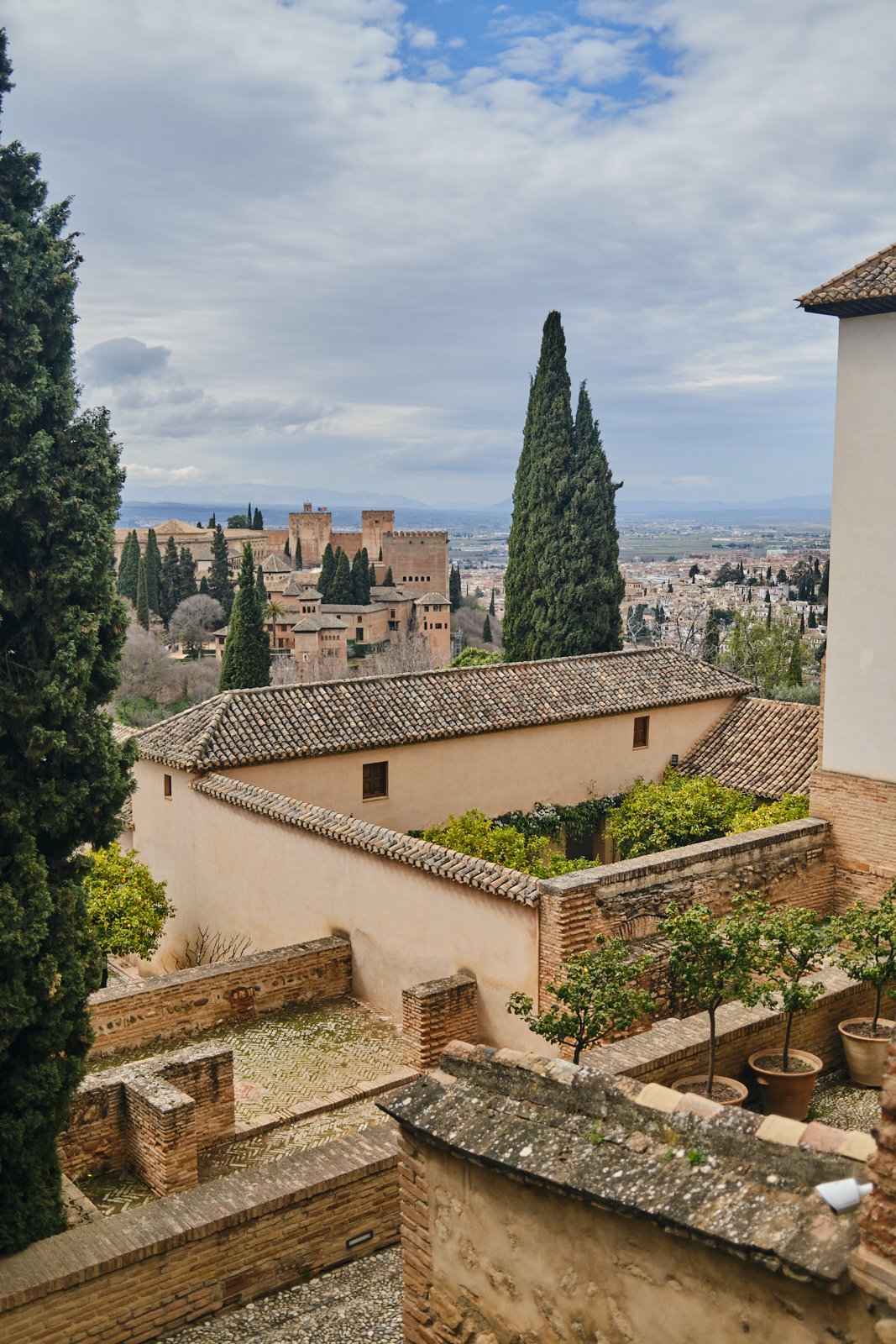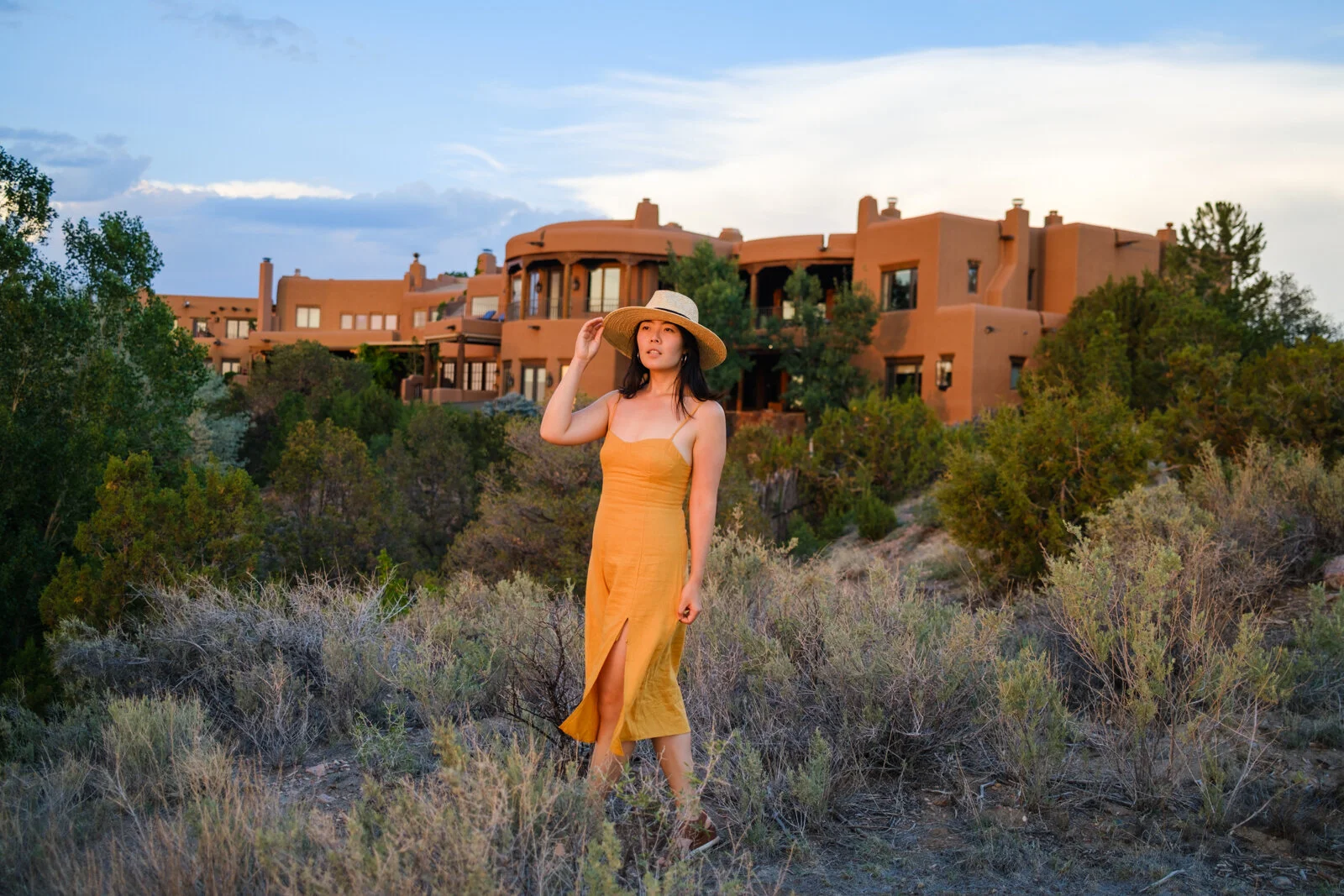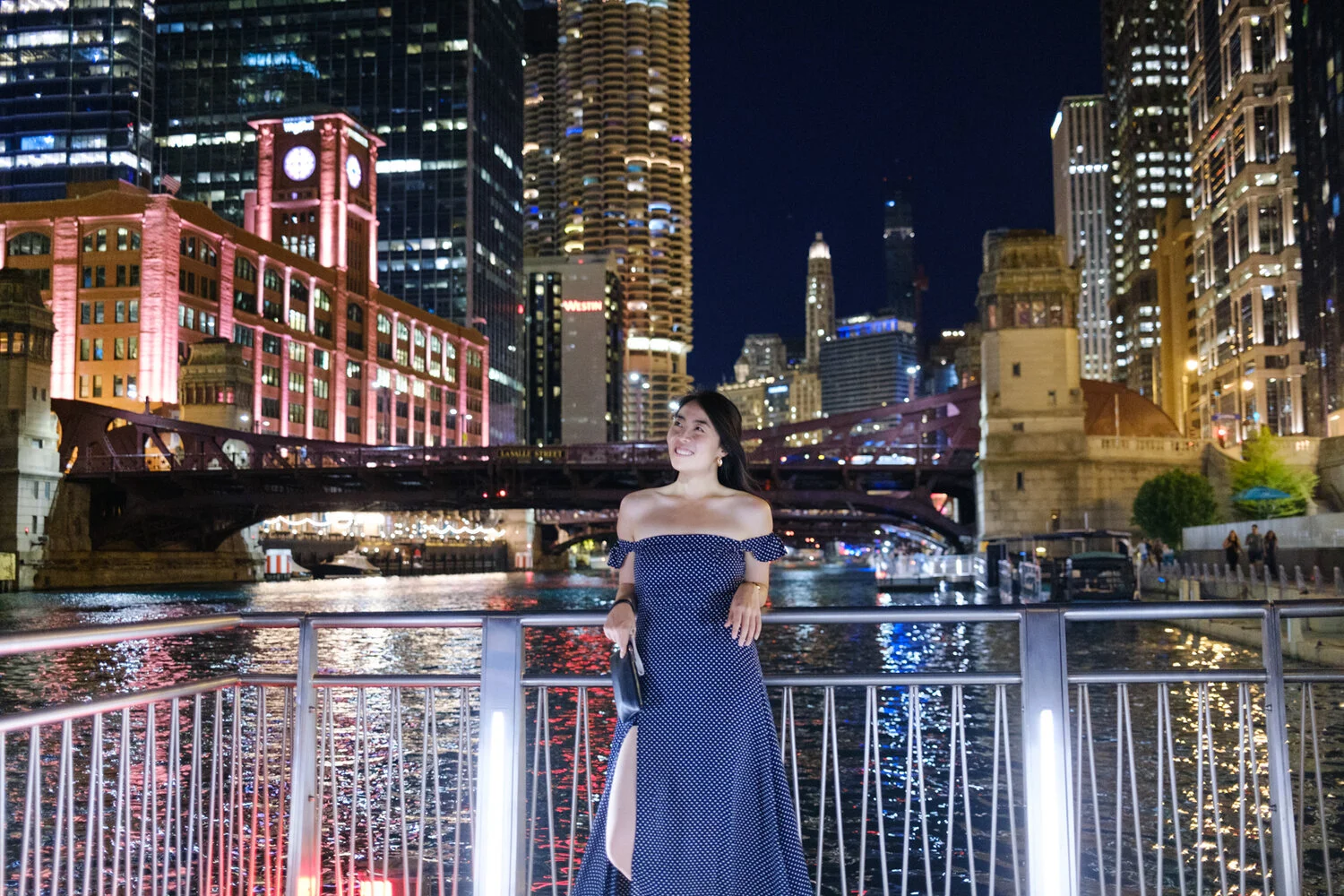Southern Spain, 2025
A spring vacation to the heart of Andalusia, in three parts.
I. Sevilla
The capital of Andalusia was our first destination. With a walkable historic center, we were excited to explore Sevilla on foot. In our two days there, we made the most of sunny moments, walking from the Centro Histórico to the Guadalquivir River to the Triana neighborhood. Beautiful orange trees lined the streets, adding to the charm of the mythical city, and we even caught a flamenco street performance outside Plaza de España.
The Royal Alcázar
The Royal Alcázar, or royal palace, is Seville’s biggest attraction. It was developed during the Islamic era, then repurposed and redecorated into the unique elaborate Mudéjar style that combines Islamic, Romanesque, Gothic, and Renaissance architecture and ornamentation.
Walking through the palace and the garden-filled complex, I was reminded of San Diego’s Balboa Park, which is made up of Spanish Colonial Revival buildings, palm trees, and acres of gardens. Did you know palm trees were actually introduced to Southern California from Spanish missionaries?
But I have to admit — my favorite part of the palace was the color scheme (I admire how they stuck to the blue and yellow palette), as well as the birds, namely ducklings and peacocks.
The Seville Cathedral & Giralda
This former mosque is now the largest Gothic cathedral in the world. It’s also the burial place of a famous colonizer you may have heard of, Christopher Columbus. The interior has the longest nave of any Spanish cathedral, with a beautiful mahogany choir loft, but my favorite part was the Giralda, the bell tower. A former minaret of the mosque, the tower has a ramped rather than stair ascent. At 24 weeks pregnant, I charged up to the top at full speed, proud to prove wrong the entrance sign that warned against “disabled” people like me and the elderly. She’s pregnant, but in no way fragile.
Plaza de España
This famous plaza is the backdrop for every Sevilla tourist photo and even a Star Wars scene, and rightly so. We were jetlagged when we got here and couldn’t appreciate it in the moment, but looking at these pictures, this place was stunning. There are pockets of this blue tile dreamscape that remind me of Disneyland and the Vegas Venetian hotel entrance. (I’m ashamed for making that comparison, but it’s true.)
The plaza was built in 1928 for a world expo, and mixes different styles of architecture seen through the tiled fountains, pavilions, and even benches within alcoves that represent different provinces of Spain. We unabashedly took a short little snooze in the Palencia alcove.
Favorite food and stay
El Rinconcillo, the oldest tapas bar in Sevilla dating back to the 1600s. It’s popular but we got there when they opened and stood at the bar to order tapas from the adorable grandpas working behind the counter. It’s so wholesome how they write your order total on the counter with chalk in front of you. Simon loved the chorizo rice.
Bar El Comercio, a popular churro and chocolate spot. Churros are almost made fresh and you can get them outside the window as a quick snack. They don’t have a sugar coating and resembled Chinese youtiao, and the chocolate dip was rich not but not overly sweet. As we finally got through the line to buy fresh churros one afternoon, it started pouring. We then risked everything to protect our afternoon treat as we spent the longest 4 minutes of my life scrambling back to our hotel.
100 Montaditos, a small bar food place we stumbled upon that sells cheap 1 euro mini sandwiches and beers on Wednesdays and Sundays. They have 100 different fillings to choose from, of varying quality, but it was fun. Be prepared to read and order in Spanish.
Joya del Casco Boutique Hotel, the hotel we stayed at (booked through Chase rewards) which included a high quality daily buffet breakfast and attentive helpful staff. It’s located at the historic center within walking distance of everything, and we opted to pay a bit extra to upgrade to the nicer room with a view of the Giralda.
II. Córdoba
Sevilla was the center of our stay, but Córdoba was close enough to be a day trip. We took the train east to visit this small historic Roman city. I love me a UNESCO World Heritage site, so imagine my surprise when I found out Córdoba contains the most UNESCO World Heritage Sites in the world for any city. Wow!
The religious: Mosque-Cathedral aka “Mezquita”
In all my time spent in Europe, I’ve visited too many cathedrals, but this one was like nothing I’d ever seen. The Mezquita is believed to be a Roman temple turned Visigoth Christian church turned Muslim mosque finally turned cathedral during the Reconquista. Upon entry, its dimness and column-filled hall is striking. The 800+ columns resemble a “hall of mirrors,” holding up candy-cane colored horseshoe arches.
The historic: Puente Romano, the Roman Bridge
In the middle of the historic center sits the Puente Romano, originally built in the early 1st century BC, most likely a part of the Via Augusta that linked Spain to Italy. The bridge has been restored and renovated many times and now serves as a pleasant pedestrian bridge for tourists to stroll across, listen to street musicians, and admire the scenery of the Puerta del Puente gate that made up the city walls. Very Game of Thrones-y.
The enchanting: San Basilion Quarter
San Basilio is a historical neighborhood where tourists come to admire the famous patios of Córdoba. Patios are the emblem of the city, so much so there’s even an annual festival held in May where locals compete to show off their patios, which has been dedicated as a UNESCO World Heritage Site. The origin of patios date back to the Roman era, when people filled theirs with water features and plants to keep cool during summer months.
Specifically, Calle de San Basilio has private patios where you can enter with donation. We only came across one, and it was quaint but beautiful. When I retire, I can’t wait to be the old lady whose only job is to water plants and maintain my patio gardens.
However, by mid-afternoon, we’d been walking around town all day and ran out of things to do. We reluctantly waited until 7pm to board our train back to Sevilla.
III. Granada
When the taxi driver pulled up to the riverfront Carrera del Darro, deep into the Albaicín neighborhood of Granada, I almost teared up. This was the destination I’d been waiting for, a city so romantic it took my breath away.
The Albaicín & more
Surrounded by the towering snow-covered Sierra Nevada mountains, Granada is one of the most charming cities I’ve seen. Winding streets run up and down the hillsides of the city, leading you through the most beautiful maze with the most rewarding miradores (viewpoints). We had two and a half days to spend here, and started it off with a guided tour of the Albaicín.
The Albaicín neighborhood has a Medieval street plan dating back to the Nasrid period, when an Islamic emirate ruled the Southern Iberian Peninsula. When Granada finally fell under the control of the Spanish monarchs Ferdinand and Isabella (who was a lady boss in her own right), the Albaicín was the starting point of a Muslim rebellion throughout Granada. In the city today you’ll see the pomegranate motif everywhere. It’s a symbol of the monarchs’ final victory over the Moors. You might also notice their coat of arms used as ornamentation over church doors, complete with a yoke, arrows, and an eagle.
The traditional type of house in Granada is called a carmen, a historic house with a terraced garden. The entryways are labeled, and there are some you can visit for free. We took a picturesque walk through Carmen de la Victoria right before sunset, before walking down over to the Roma community of Sacromonte to catch flamenco performers getting ready their dinnertime show inside the caves of the hillside. (We didn’t feel like committing to a whole flamenco show this time around, but it’s a popular thing to do in Andalusia.)
The city is relatively hilly, but nothing compared to Lisbon. I definitely recommended good walking shoes.
The Alhambra
Growing up in Los Angeles, I took for granted how many of our cities, streets, and natural landmarks are named after Spanish ones. Of course the Granada mountain ranges are also called Sierra Nevada. And of course the famous palace complex and fortress is called the Alhambra.
The Alhambra is maybe Spain’s most-visited attraction, a ticket that you have to secure months in advance when planning a visit. I dedicated a whole day’s itinerary to this place, and we spent 5 hours walking around the Nasrid Palaces, the Alcazaba fortress, and Generalife summer palace and gardens.
Like many of the other architectural sites we visited on this trip, the palaces are a prime example of historic Islamic styles fused with Spanish Renaissance elements. Very Mudejar. Built by the Nasrid emir in the mid-13th century, the complex sits on a plateau overlooking the city. It served as the royal residence and court of Granada until 1492, a fateful year you might recognize. Turns out Ferdinand and Isabella completed their Reconquista early that year when they conquered Granada, settled into the Alhambra palace, and then endorsed Christopher Columbus for his royal expedition to “discover” America. This was the room where it happened!
Before before the Spanish arrived, the Alhambra served as a city within a city during the Nasrid era. It had a water supply system and even a military quarter where guards and their families lived. The complex has gone through lots of disrepair and restoration work over the centuries, which explains why some walls look intricate, but others completely plain. In the early 20th century, architect Leopoldo Torres Balbás was appointed curator and chief architect of the Alhambra. His restoration work is the reason we could preserve such a monumental gem into the modern day.
Even though it required a lot of walking (I proudly logged 23,000 steps that day), seeing the Alhambra was magical because of the vantage points it offered of the city below. Perfect cypress trees in the distance create a romantic ambiance, especially seen through double arched windows. Imagine living here opulently as a sultan enjoying your hammam baths, reflecting pools, and manicured gardens. What a life.
Visitor tips: Book a early time slot to begin your visit, eat at a filling breakfast, wear good walking shoes, and bring snacks, water, and your passport. Your time slot is only valid for the Nasrid Palaces, which I recommend you start at. The other areas (Alcazaba and Generalife) you can enter at any time of the day at your own pace. The complex is big, so look at the map ahead of time and make sure you commit to a start and end so you don’t waste too much energy retracing your steps because you missed an attraction on the other end of the hillside.
Getting there: Our Alhambra day started early, but I was determined we could make it up to the Alhambra on foot from our central Airbnb location without the bus. We had breakfast near Plaza del Realejo and found shortcut pedestrian stairs that led up the hillside without having to follow the switchback roads meant for vehicles. Sweaty but excited, we made it just in time.
The view from our Airbnb rooftop.
Favorite spots in Granada
Carrera del Darro, a narrow romantic waterfront road we walked everyday to leave our Airbnb. On the last day, we actually walked right into people practicing for a Holy Week procession.
Monasterio Santa Isabel la Real, a monastery where you can buy sweet treats from unseen nuns via lazy susan
Carmen de la Victoria, a beautiful carmen owned by the university that’s free to enter (buzz the ringer to be let in)
Plaza de Bib-Rambla, a central square surrounded by good restaurants
Los Manueles for tapas and traditional Spanish food. We ate here twice and loved the albóndigas, croquetas, and the house salad. They have multiple locations around Granada but the Calle Monjas del Carmen spot was my fave.
I Need Coffee, a breakfast place that actually opens early enough for you to fill up on a hearty breakfast before a long day at the Alhambra
Los Diamantes for all the fried seafood. They give the free tapas with drinks!
Cafe Ysla for pionono (a local jelly sponge cake specialty) and other treats. Simon tried his first sachertorte
Mirador de San Cristobal and Mirador de San Miguel Alto, for views of the rolling hills and majestic Alhambra at sunset. (It reminds me of the P hike in SLO)
Muglia II, for cozy Indian food in case you need a break from heavy Spanish food
Alhambra Churreria for churros con chocolate! My kind of nightcap.
Andalusian food
I love the idea of tapas and couldn’t wait to spend time at a city that still gives them out for free with drinks (Granada). But throughout our culinary adventures over the course of a week in Spain, we learned some things:
Meals happen late. Peak lunchtime is 2pm, while peak dinner is 10pm. So if you eat early you do have a better chance of securing a seat at popular restaurants. However, there was almost no food to be found between 3-8pm. (But that’s what dessert places are for.)
Most desserts aren’t as sweet. But if they are, they’re meant to be paired with a bitter espresso.
A common breakfast is tostada con tomate which is an open faced large piece of oblong ciabatta rubbed with a layer of tomato, garlic, and olive oil. Yum.
Iberian ham is everywhere. I tried to stay away for food safety reasons but gave in halfway through the trip. Let the pregnant lady live a little.
Menú del día is a daily lunch special offered by many restaurants. It’s economical and offers a balanced and filling three-course meal.
Tapas are great way to try things, especially if you have no idea how they’ll end up tasting. In Sevilla, we pretty much ate tapas exclusively, and just tried as much as we could until we got full.
Montaditos and bocadillos are Spanish sandwiches with different fillings. Great for bringing on the go.
Drinks are cheap and basically same price as water (2 to 2.50 euros), so order that sangria. Caña refers to a glass of draft beer.
Spanish food can get kind of heavy, fried, and salty, so every few days I’d lobby for a different cuisine just to switch up my palette. Sadly, not many Asian food options.
Other Tips
The locals’ English-speaking skills aren’t always great but they understand you. I love practicing my Spanish as much as possible, but waiters always respond in English lol. (Except for one instance where I converted a waitress from speaking English to Spanish to me just for a second). Learn how to ask for the bill, communicate whether you’re dining in or takeout, and everything else on the menu you can just point to.
Tipping isn’t expected
Take siestas. To not tire yourself out while on vacation, and respect Spanish tradition, obviously.
It’s pretty easy to train or bus to cities in Andalusia, and so I don’t recommend renting your own car if visiting the “bigger” cities with historic centers. They’re full of windy tight turns and roads reserved for taxis only.
Fly out of Granada from Málaga airport, which is a two-hour bus ride away. We booked tickets 2 days in advance via Alsa.
Andalusia is typically a warm destination, but this winter in Europe saw an unprecedented amount of rainfall late into spring. Half our days were met with some amount of rain, which made walking around slippery alleyways just a little bit less romantic. However, summers are extremely hot in Southern Spain, so visit in April or May to catch the perfect weather and exciting holidays like Holy Week and the Courtyards Festival in Córdoba.
Last but not least, I didn’t try hammam (Turkish baths), but would love to on another visit!
A decade of traveling
This trip marked my 10-year anniversary of traveling.
In March 2015, I took my first trip (without my family) to Seattle, where I spent a few days with my class learning visiting architectural firms and admiring high rises. I booked my own flight for the first time, and spent a whole night sleeping on benches at SeaTac after miscounting the number of nights I’d need at the hotel. I also remember not wanting to go out with my classmates to get sushi dinner because I didn’t want to spend money. Instead, I stayed behind in the hotel room alone and Facetimed my friends, including Simon.
But that trip kickstarted a decade of adventures. Later that fall, I studied abroad in Rome for a semester, during which when I learned how to solo-travel in foreign countries and fall in love with exploring the world unknown. After college, a steady income gave me more budget for trips, during which I ventured to new places far and wide with my sister and eventually, Simon. Covid hit halfway through the decade (as we all know), but these past two years, we’ve more than made up for lost time, bouncing between continents every other vacation to squeeze in as many experiences as we could between Asia, Europe, Latin America, the U.S. It’s been so meaningful and fulfilling, but alas I am tired. Timing couldn’t be more perfect as I’m re-evaluating the way we’ll need to travel with the impending arrival of a little one. What a way to bookend a beautiful, adventurous decade.









































































































































































